<<PREVIOUS -
HOME -
CONTENTS -
NEXT>>
DOUBLE STARS INDEX -
![]()
<<PREVIOUS -
HOME -
CONTENTS -
NEXT>>
DOUBLE STARS INDEX -
![]()
Introduction
The quality of measuring double star separation (rho) and position angle (theta) are dependent upon the quality of the image used for these measurements. Below is the analysis of five images of the double stars KUI82AB-C. Star measurements include FWHM with its sigma, peak pixel value, brightness and star shape which show the roundness of the star. These star measurements were taken with AIP4WIN V2.4.8B.
The star quality data analysis was preformed on a MacBook Pro laptop running OS X 10.8.2 Mountain Lion with Parallels Desktop 8 for Mac virtual machine to run Windows 7 Professional SP1 in order to run AIP4WIN. The five KUI82AB-C images 5970 to 5974 were taken by Tom Frey with his Alt-azimuth Dob and Canon EOS T2i DSLR camera. These images were taken with a with a motor driven alt-azimuth DOB (Dobsonian telescope) telescope without a field rotator and a DSLR (digital single-lens reflex) camera. Therefore, the star roundness is affected by the field rotation.
Star Quality Analysis Summary
The below images were converted with GIMP from the Canon CR2 file format to PNG file format. The PNG file was processed with a Python script to crop the image and to label the two double stars KUI82AB and KUI82C. The KUI82AB is a very close double star that is no resolved in the images. The north direction is approximately the 10 o'clock position on the images. The images were taken with exposures ranging from 2.0 seconds to 3.2 seconds.
Visual inspection shows image 5970 to be not as bright while the rest of the images seems to be approximately the same brightness.
Image 5970 looks sharper than the rest of the images. The sharpness of images 5971, 5972 and 5973 look the same. Image 5974 is elongated in the vertical direction.
Image 5970 |
Image 5971 |
Image 5972 |
Image 5973 |
Image 5974 |
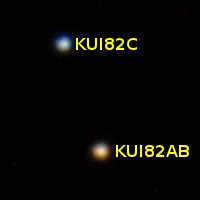 |
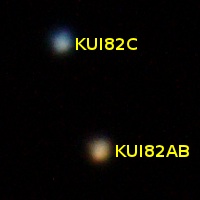 |
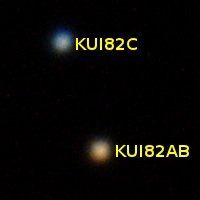 |
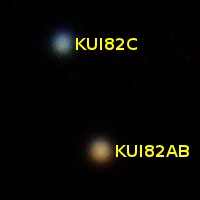 |
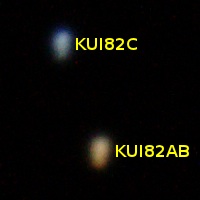 |
One measurement of sharpness is FWHM and it is affected by focus, seeing, optics quality, star tracking by the mount and field rotation. The best star FWHM is image 5970 KUI82AB and the worst star FWHM is image 5974 KUI82AB. Notice, image 5970 was the shortest exposure at 2 seconds, it has the best FWHM and it has the highest pixel value of 16,673.5. This shows the importance of good focus and good seeing on the quality of the image data. Image 5974 is the longest exposed image at 3.2 seconds, but the photons have been spread over more pixels than the other images and as a result the peak pixel value is not as high as some of the other images. The highest brightness for all images is the image 5974 at 1,835,567, but its FWHM is the worst. Brightness sums all the star light pixels and subtracts the background sum from the star sum.
Photon noise is measured by signal-to-noise ratio (SNR) which is given by the average number of event N divided by the standard deviation of the shot noise which is equal to square root of the average number of event N. SNR equation reduces to square root of the average number of event N. The number of events is the number of photons. The gain of the Canon EOS T2i DSLR camera is needed in order to convert the ADU vales to photons.Image 5970 KUI82AB |
Image 5971 KUI82AB |
Image 5972 KUI82AB |
Image 5973 KUI82AB |
Image 5974 KUI82AB |
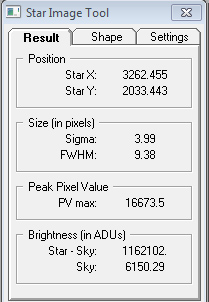 |
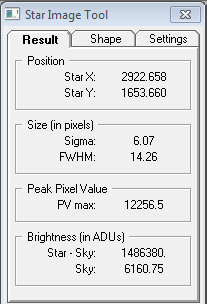 |
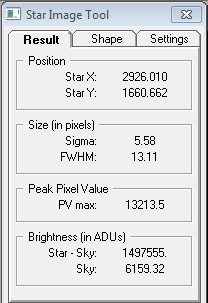 |
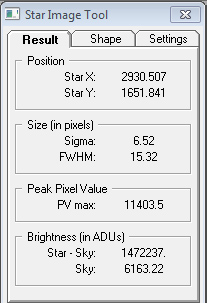 |
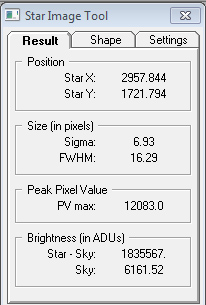 |
Image 5970 KUI82C |
Image 5971 KUI82C |
Image 5972 KUI82C |
Image 5973 KUI82C |
Image 5974 KUI82C |
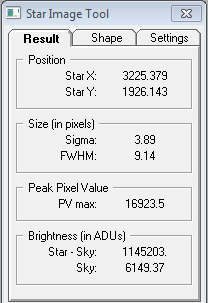 |
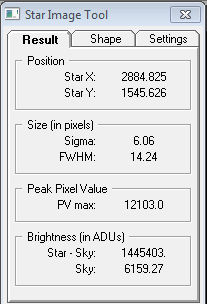 |
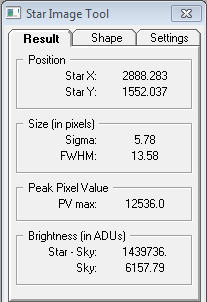 |
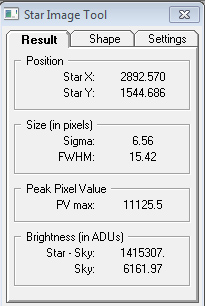 |
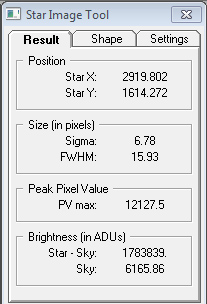 |
To quantify the stars shape the roundness of the stars are measured with AIP4WIN and the results are shown below. The shape plots show the narrow FWHM of image 5970 and the wide FWHM of image 5974.
The best star shape measurement is image 5972 KUIAB and the worst star shape is image 5974 KUIAB.
Image 5970 KUI82AB |
Image 5971 KUI82AB |
Image 5972 KUI82AB |
Image 5973 KUI82AB |
Image 5974 KUI82AB |
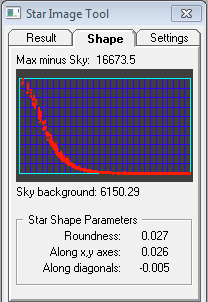 |
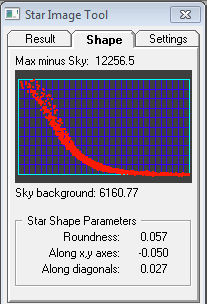 |
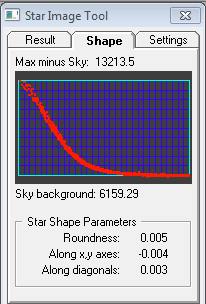 |
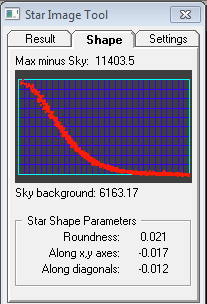 |
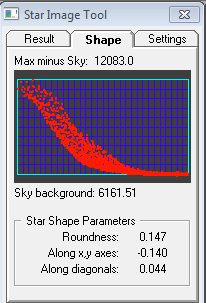 |
Image 5970 KUI82C |
Image 5971 KUI82C |
Image 5972 KUI82C |
Image 5973 KUI82C |
Image 5974 KUI82C |
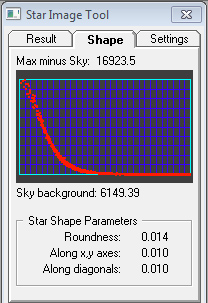 |
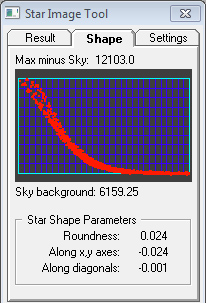 |
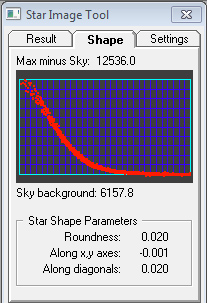 |
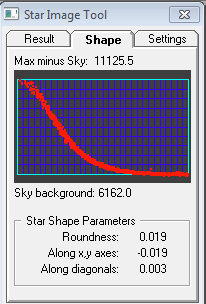 |
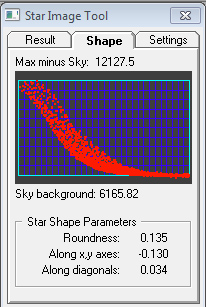 |
AIP4WIN Data Analysis Process
The images were taken by a Canon EOS REBEL T2i. The Canon DSR raw color CR2 file is opened and converted to a grayscale image. The Display white point is increased to display a dark gray sky back ground.
AIP4WIN Star Data Tool is used to measure the quality of the primary and secondary stars in each image.
AIP4WIN Star Data Tool Setup
The first step to using the Star Data Tool is to adjust the Star Data Tool settings located in the settings tab. The first radii should include all of the star light but do not include unnecessary sky background by making the radii to large. For this example the first radii was set to 25 pixels. Therefore, the star light is calculated from a the yellow circle of 25 pixels.
The Star Data Tool settings second and third radii determine the image area where the sky background is measured. Make sure this donut area does not include other stars or objects that are not part of the background. For this example the second radii was set to 30 pixels and the third radii was set to 40 pixels. The sky background is calculated from the blue ring of 30 to 40 pixels from the center of the star.
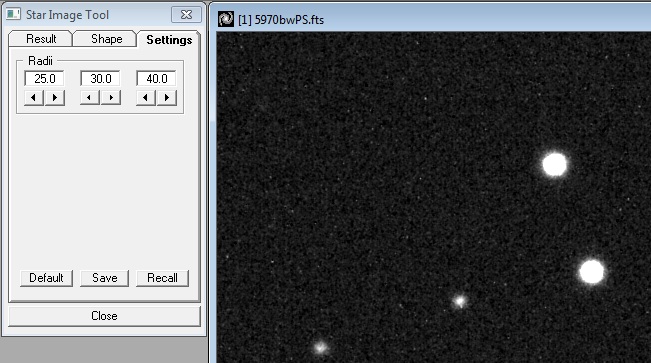
AIP4WIN Star Data Tool Results Tab
The AIP4WIN Star Data Tool Results tab is used to measure the star location, FWHM with sigma, maximum pixel value, sky back ground brightness and the star brightness minus the sky back ground brightness.
With the Star Data Tool Results tab shown, click on the center of the star to be measured. AIP4WIN will find the exact center of the star in pixel values and show the star's position in sub pixel resolution.
Smaller FWHM values indicate better focus, less telescope vibration during the exposure, better telescope tracking, less field rotation and better seeing conditions.
The FWHM are in pixel values. To convert the FWHM to arcseconds we need to know the Canon EOS REBEL T2i pixel size (4.3 microns) and the focal length of the telescope (2020.6 mm which as determine by the AIP4WIN Astrometric tool). The formula for arc-sec per pixel is (206.265)*(pixel size 4.3 microns)/(focal length 2020.6 mm)= 0.4389 arc-sec per pixel. Therefore, the FWHM iin arc-sec is 9.38 * (0.4389 arc-sec per pixel) = 4.12 arc-sec.
The peak pixel value of KUI82A in image 5970 is 16,673.5 which is higher that the 14-bit maximum value of 16,383. This is the effect of the Bayer to grayscale conversion. The raw CR2 file before Bayer conversion will provide the maximum pixel values which will determine if the data has been overexposed and clipped.
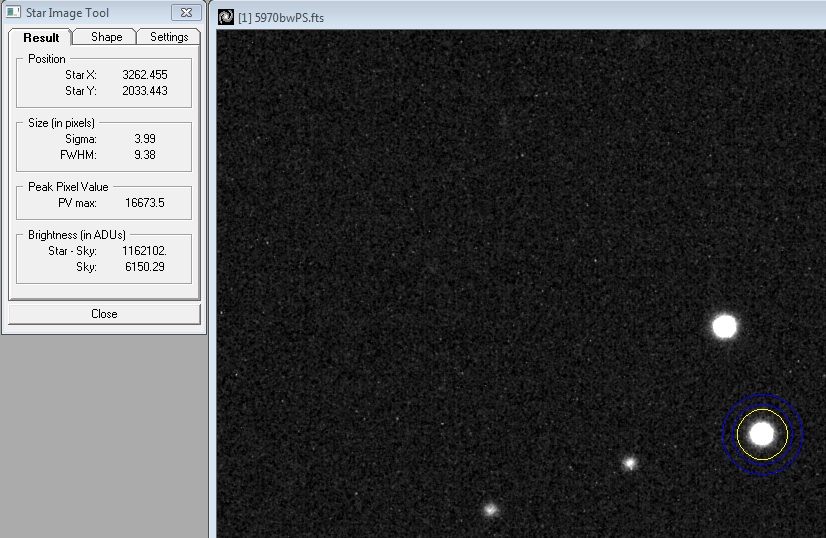
AIP4WIN Star Data Tool Shape Tab
The AIP4WIN Star Data Tool Shape tab measures the roundness of the star.
With the Star Data Tool Shape tab shown, click on the center of the star to be measured. AIP4WIN will find the exact center of the star in pixel values and show the star's position in sub pixel resolution.
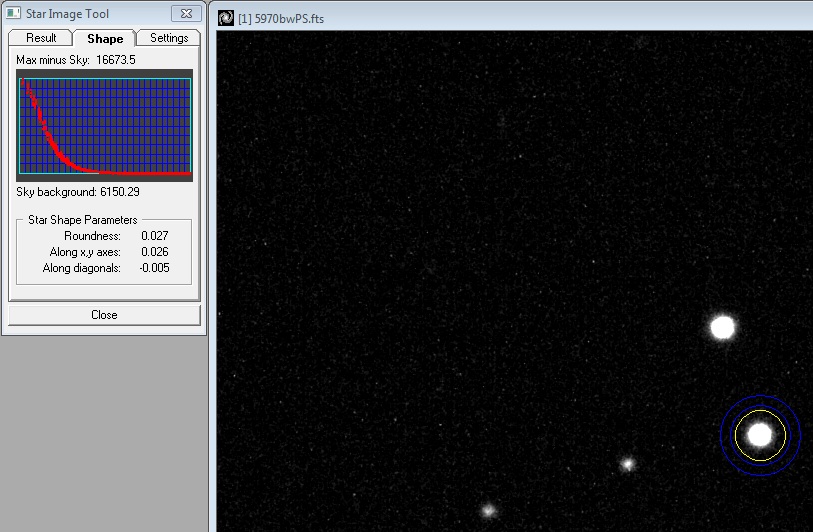
Links ![]()
References
|
|
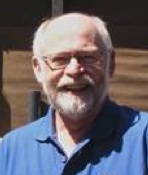
Thomas G. Frey Thomas G. Frey is Professor Emeritus of Chemistry at California Polytechnic State University, San Luis Obispo, CA. He has been an active member of the Central Coast Astronomical Society for over 25 years. He was a team leader at the Pine Mountain Observatory (PMO) Summer Science Research Work- shop, Bend, OR, 2009 and co-director of the PMO workshop, summer of 2011. |
|
|
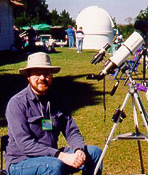
David Haworth enjoys astronomy imaging and processing those images to bring out details that cannot be seen easily by visual observing with the same size optics. David Haworth started astroimaging with a Cookbook CCD camera he built in 1996 and since then has used many types of cameras to image the sky. David wrote Chapter 2: "Afocal Photography with Digital Cameras" in the second edition of "The Art and Science of CCD Astronomy" which was published in December 2005. David's images have appeared in magazine front covers, articles, books, catalogs, videos, music CD covers, T-shirts, other web sites, etc. |